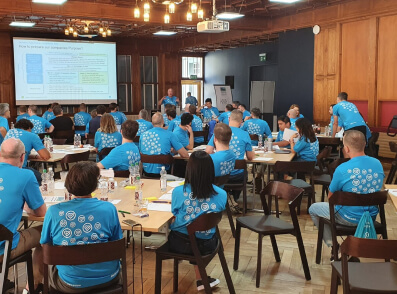Key Takeaways
- Life and health insurers waste millions annually on inefficient claims processing, outdated underwriting, and legacy technology systems.
- Cut costs by implementing AI claims processing, digital health platforms, predictive analytics, fraud detection, system consolidation, data-driven retention, and cloud migration.
- Forward-thinking insurers go beyond cost reduction to create new revenue opportunities through strategic data monetization.
Insurance Cost Management: 7 Ways to Reduce Your Operating Costs
Operating costs eat away at insurance profits. Outdated systems, manual processes, and inefficient operations drain resources that could otherwise boost your bottom line. The health and life insurance industry faces particularly steep challenges with rising claims costs, strict regulations, and changing customer demands.
Most insurers respond with basic cost-cutting that risks service quality. This approach falls short. Today’s market requires smart cost management strategies that enhance efficiency while improving customer experiences. This article shows you seven proven ways to reduce operational costs through digital solutions that deliver measurable results.
Insurance Operational Costs: Where the Money Goes
Before examining cost reduction strategies, insurers must understand their major expense categories:
- Claims and Benefits: Processing represents the largest expense for health and life insurers. These costs include not just the actual payouts but also the administrative expenses of processing claims. Insurance companies spend significant resources on staff, systems, and procedures to verify, assess, and settle claims.
- Underwriting and Risk Assessment: These tasks require substantial resources to evaluate applicants, determine appropriate coverage, and set premiums. Traditional underwriting processes often involve manual reviews, medical examinations, and extensive documentation.
- Customer Acquisition and Retention: Thesecosts continue to rise in competitive markets. The expense of acquiring new customers through marketing, sales, and distribution networks often exceeds the first-year premium income from those customers.
- Administrative Overhead: This encompasses everything from office space to executive salaries to regulatory compliance costs. These expenses support core operations but don’t directly generate revenue.
- Technology: Techinfrastructuremaintains the systems that power modern insurance operations. Legacy systems often require expensive maintenance while providing diminishing returns on investment.
7 Health and Life Insurance Cost Management Examples
1. AI for Claims Processing
Your manual claims process creates bottlenecks and drives up costs. AI systems automate routine tasks while flagging complex cases for human review. According to an insurance case study in a recent Accenture report, an AI-based system led to as much as a 73% increase in claims process cost efficiency.
AI excels at sorting claims, extracting document information, and spotting potential fraud. You’ll process more claims with fewer staff while reducing costs per claim and speeding up settlements.
2. Digital Health Platforms
As a health or life insurer, you can reduce claims processing by reducing claims themselves. How? By encouraging preventive care.
Digital health platforms transform customer interactions through health tracking, guidance, and incentives. A study in Preventive Medicine showed these platforms reduced healthcare costs by 4.9% in year one and 5.3% in year two, saving approximately £133-152 per person.
dacadoo Digital Health Engagement Platform (DHEP) takes this concept and makes it accessible to insurers. Our app gamifies health tracking, enabling continuous engagement while providing valuable health insights for better risk assessment.
3. Predictive Analytics for Underwriting
Traditional underwriting creates inefficiencies through slow processing, inconsistent assessments, and pricing errors. Predictive analytics transforms your approach by analyzing vast data sets to identify patterns with greater accuracy. An International Journal study found that advanced analytics cut underwriting time by 67.5% while also increasing accuracy.
For example, dacadoo’s Risk Engine uses between 4 and 90+ data points to generate more than 70 health indicators, with an accuracy of 91.6 % (ROC-AUC). With it, you’ll see faster processing, better risk classification, lower expenses, and fewer surprise claims.
Learn more about how data-driven underwriting is changing how insurers assess risk.
4. Fraud Detection
According to the National Insurance Crime Bureau, insurance fraud costs the industry over $300 billion annually. By implementing advanced fraud detection techniques, you’ll reduce both direct losses and the costs of investigating fraudulent payments.
Traditional methods typically catch fraud after payment, but advanced analytics can identify potential fraud before you pay claims.
These systems analyze data patterns across thousands of claims simultaneously, spotting subtle connections that indicate fraud. The technology identifies unusual billing patterns and unnecessary procedures that might otherwise slip through.
5. Consolidated Systems
Your operations likely involve multiple systems that create redundant functions, integration problems, and high maintenance costs. System consolidation cuts expenses by eliminating duplicates and creating a more cohesive environment. Insurers should first look at what systems they’ve got, then identify opportunities to eliminate rarely used applications and combine similar functions.
While consolidation requires initial investment, the long-term benefits make it essential for sustainable cost management. Your simplified technology environment will also create greater organizational agility, enabling faster implementation of new capabilities.
6. Data-Driven Customer Retention
It’s a well-known fact—acquiring new customers costs more than keeping existing ones. By prioritizing customer retention, you’ll reduce marketing expenses. Plus, digital engagement through data-driven initiatives transforms your annual renewal interaction into an ongoing relationship that builds loyalty.
According to a McKinsey report, insurers who employ advanced data analytics can see their customer retention jump from 5% to 10%. Data can reveal the experiences that influence renewal decisions, allowing for personalization and targeting. Personalized communication then delivers customized information about coverage and savings opportunities.
For more, see our article on customer retention strategies in life and health insurance.
7. Cloud Infrastructure
Your on-premises technology creates significant expenses through hardware purchases, data centers, maintenance staff, and upgrade cycles. Cloud computing transforms this into a flexible operational expense model where you pay only for resources you use.
According to McKinsey, cloud technology will generate $70-110 billion in value for the insurance industry by 2030—with insurers typically seeing 20-30% cost reductions after migration. How? The cloud model handles varying workloads efficiently, scaling up during enrollment periods without maintaining excess year-round capacity.

Beyond Cutting Costs: Data Monetization
Reducing costs is just the beginning. Your insurance data holds significant revenue potential that extends beyond operational savings. Forward-thinking insurers now treat their data as a strategic asset to create new revenue streams.
You can monetize your insurance data through improved pricing models, dynamic risk assessment, and even external partnerships. Many insurers also leverage their data resources by offering anonymized insights or analytics services to healthcare providers and other organizations.
Just keep in mind—the most successful insurers balance innovation with privacy safeguards, ensuring regulatory compliance while maximizing data value.
See our blog to learn more about data monetization strategies in insurance and how they can transform your business.
Save with Data-Driven Insurance Cost Management
Insurance cost management through digital transformation delivers measurable business value while improving policyholder outcomes.
Insurers looking to transform their operations while reducing costs need proven solutions backed by real-world evidence. The dacadoo DHEP and Risk Engine are proven ways for organizations to enhance efficiency while improving customer engagement.
Contact us to learn how our platforms can help your organization achieve similar results.





















